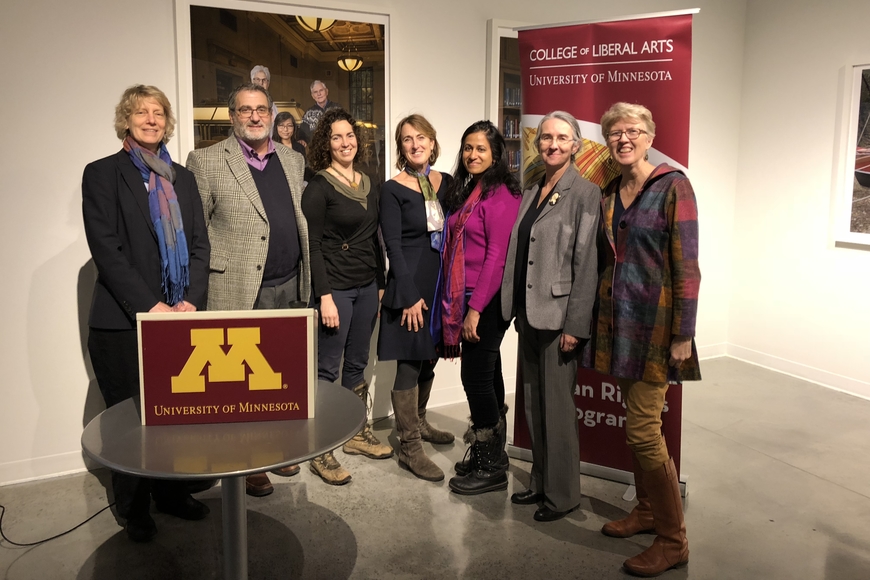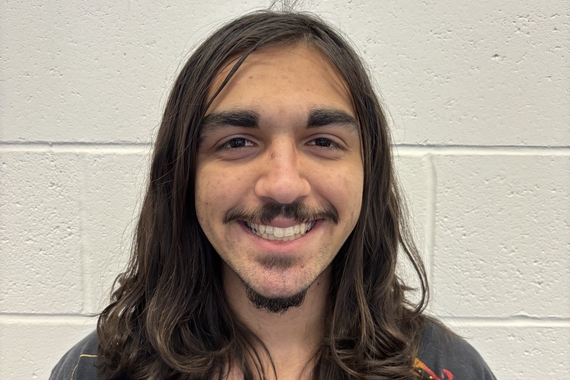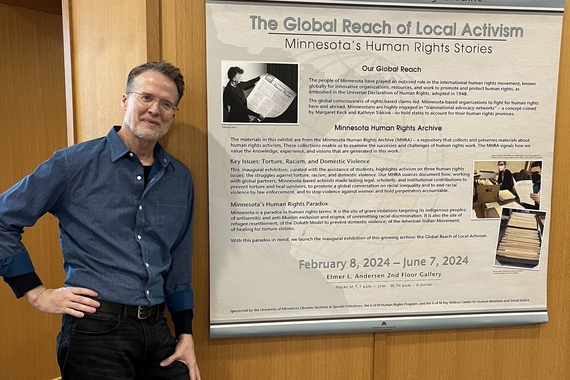Interdisciplinary Innovations in Human Rights Research Presented at the Human Rights Initiative Research Symposium
The power of interdisciplinary scholarly engagement to further human rights work was on full display during the Human Rights Initiative (HRI) Research Symposium on November 13th. Held in the Regis Center for Art, four HRI funded research teams presented their current work surrounded by stunning portraits of College of Liberal Arts faculty and students currently on display. Carissa Slotterback, Associate Dean of the Humphrey School of Public Affairs warmly introduced the event to the crowd of community members, students, and faculty followed by Elizabeth Boyle, Chair of the Human Rights Faculty who introduced the research teams.
Greta Friedemann-Sánchez, Associate Professor at the Humphrey School, presented her research team’s work investigating the implementation of Colombia’s 2006 law criminalizing domestic violence; recognizing women’s right to live free of violence. Partnering with now graduated Master of Public Affairs student Peggy Grieve, Friedemann-Sánchez travelled to Colombia to interview over 160 key informants to understand the ways in which the law was or was not successfully implemented on the ground. Interviewees included NGO workers, academics, city officials, and judges. The team also interviewed municipal level family commissioners who are responsible for implementing many of the provisions of the laws on domestic violence. Their duties resemble the work of both judges and social workers.
Despite the Colombian people declaring that “La Ley es Bonita” (the law is beautiful), referring to the watershed 2006 law, Friedemann-Sánchez and Grieve found that the implementation leaves much to be desired at this point. Although Colombia is considered a post-conflict country, Friedemann-Sánchez notes that “violence moves from the battlefield to the homefront” as evidenced by the extremely high rates of domestic violence, particularly against women. Friedemann-Sánchez and Grieve found based on their extensive qualitative data that family commissioners, key players in the law’s implementation, have too many wide ranging responsibilities to do any of them effectively. Their workload is too high, their resources too little, and their municipal level administration is often disconnected from national decisions further complicating their work.
Friedemann-Sánchez and Grieve, in partnership with the Minnesota-based NGO The Advocates for Human Rights took their findings to the United Nations Human Rights Council in March of 2018 to share their results and offer recommendations. The team suggests that in the short term, family commissioners’ workloads should be narrowed, and a certain amount of funds funneled from the national to the local level should be earmarked for family commissioners’ work. Specifically, the Colombian Ministry of Health should fund shelters and mental health services for domestic violence victims. In the long term, the team proposes a system restructuring that places family commissioners within the judicial branch, and that the national government must recognize that, according to Friedemann-Sánchez, “without peace in the home, Colombia won’t find peace” at all.
Shifting from Colombia to Israel, Sonja Kuftinec and Avigail Manneberg presented their research project entitled “A Contested Home.” Both are artistic scholars; Kuftinec studies theater as a medium of conflict transformation and Manneberg is a visual artist. The team sought to engage with Israeli residents living in Ya’ad, a village in the Galilee with a contested history. Palestinians with Israeli citizenship (PICs) once called the same area home, but were forcibly displaced after the 1948 war and their village was destroyed. Later in 1974, Jewish Israelis moved into the area and built up their own village, present day Ya’ad. Today, founders of Ya’ad and their descendents still live in the village, while the PICs and their descendants live nearby. However, the space between the two groups is cut off by a large, structural barrier. For both groups, talking about the history of what they both call their homeland is painful and contentious.
Kuftinec and Manneberg sought to bridge this divide. According to the team, they envisioned using “art as a space of encounter, a mode of encountering repressed narratives and counter narratives through intimacy with one’s self and another.” Manneberg also approached this work through a unique, personal lens. She, a Jewish Israeli herself, grew up in Ya’ad and still has family living there. However, she soon realized that after having been away for so long, she needed to recultivate relationships and trust with her former neighbors, a challenge the research team did not initially anticipate.
Eventually, the team organized a workshop for Jewish artists to begin understanding Palestinian narratives about the historical and cultural trauma their people experienced as a result of the forced displacement. The research team brought a group of local Isreali artists to a space that is particularly contested between the two groups, and facilitated exercises centered in “artistic means through which individuals could open themselves to listen to the testimonies [of Palestinians].” Activities included individual engagement with the space through making sound recordings with a focus on both internal and external noise. Participants also created collages that integrated images from the past and present of the space. As a result, in December a community event focusing on these contested narratives and the experiences of the Israeli artists will be held in Ya’ad.
The researchers have applied for another grant from the HRI fund and hope to use that money to continue with their project. Next, they’d like to engage in a similar exercise with Palestinian artists.
Moving ahead to present day, History Professor Patrick McNamara presented on his work examining the current state of Internally Displaced People (IDPs) in El Salvador, the Salvadoran government’s response, and the variables that are causing people to flee their homes in the country. McNamara noted that displaced people from Central America, including those from El Salvador have been front and center in the news as of late with ongoing talk about the “Migrant Caravan” seeking asylum in the United States. McNamara notes that this is mainly because El Salvador has no effective plan for the large number of displaced people in the country, many of them now choosing to move north seeking safety and security.
Methodologically, the research project proved quite difficult. McNamara hoped to gather information from a number of sources including IDPs themselves, and also hoped to determine a more accurate count of the number of IDPs currently in El Salvador. The latter goal remains elusive as there are major discrepancies between government tallys and researcher estimates about the number of IDPs in the country. However, McNamara suggests that there may be as many as 300,000. Further, McNamara encountered unexpected barriers in talking to IDP families. Although he maintains trusted relationships with people on the ground in El Salvador with ties to IDP families, even this personal connection was sometimes insufficient to gain trust from interviewees. According to McNamara’s experience, families are generally unwilling to share their experiences with researchers because they are terrified that their new living location will be compromised. Many could not get through sharing their personal story of displacement without crying, and often would conceal some painful aspects of their experience. All of the people he talked to experienced trauma at some level including disappeared loved ones, extortion, and gang harassment amongst other things. As such, sometimes interviewee narratives were fragmented, or individuals struggled to remember everything.
Ultimately, McNamara came up with a number of findings as a result of this rigorous research process. He recommends first and foremost that the Salvadoran government designs an established, consistent, and long term approach to dealing with IDPs as they are not currently meeting their responsibilities under the 1998 Guiding Principles on Internal Displacement. Additionally, effective humanitarian solutions for IDPs would contribute to easing human rights challenges for Salvadoran IDPs, as well as those seeking asylum in places like the United States. McNamara emphasizes that if the United States decides to eliminate Temporary Protected Status for Salvadorans in the United States, upwards of 200,000 people would be forcibly returned to El Salvador as early as 2019, adding to the IDP population.
Finally, the last presenter V.V. Ganeshananthan took the audience back across the globe to Sri Lanka. A fiction author, journalist, and professor, Ganeshananthan writes about Sri Lanka’s Civil War through the lenses of non-traditional narrators. These include, for example, women, civilians, or children inside of Sri Lankan civil society. During her presentation, Ganeshananthan teased her next project currently in progress by reading a powerful passage from the book-to-be. This piece was a description of the experiences of a young woman helping the Tamil Tigers.
Ganeshananthan expressed her gratitude for the HRI grant funding that she received which is enabling the translation of her work into Sinhalese and Tamil, the two official languages in Sri Lanka, aside from English. She is hoping for feedback from the people who she is writing about. She ended her talk by adding, “getting those people on the page, is really my project. And getting those people to read my work would not be possible without this program.”



